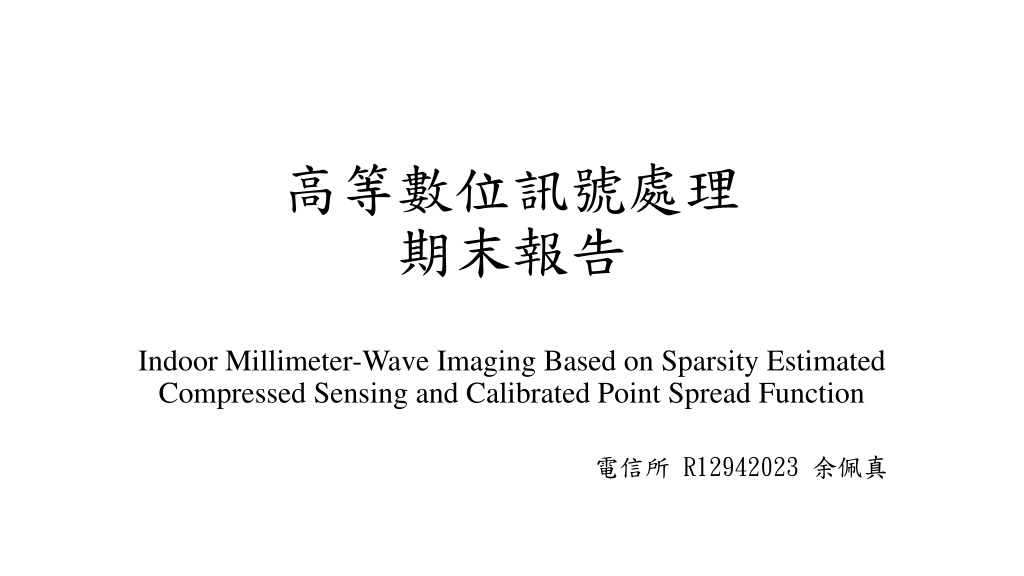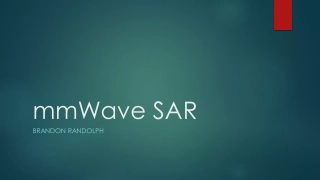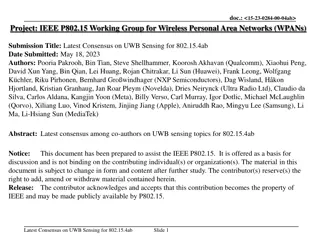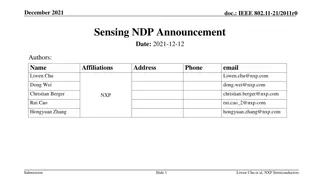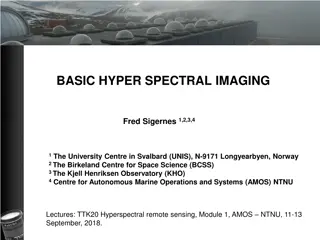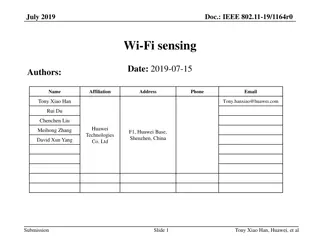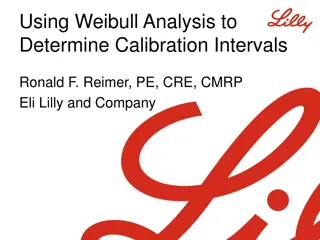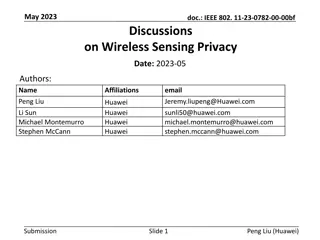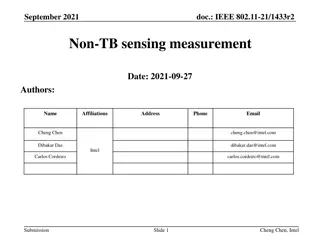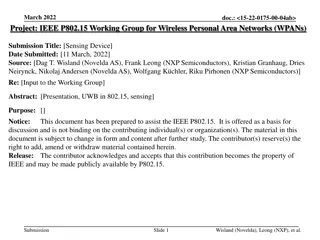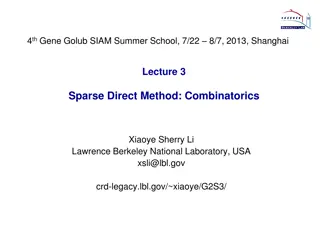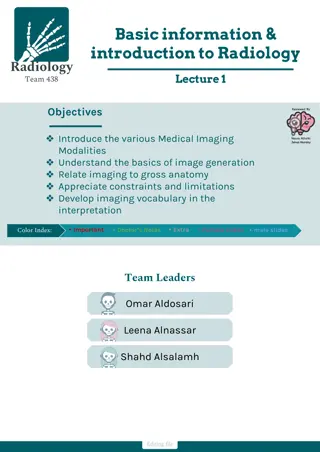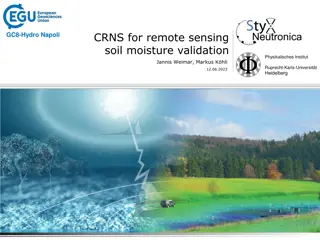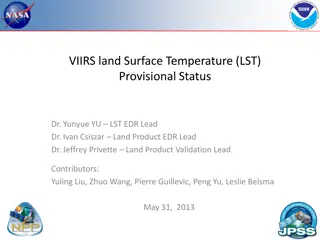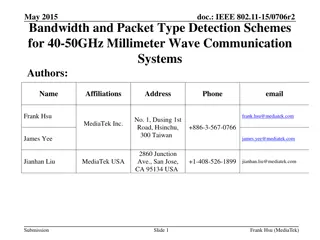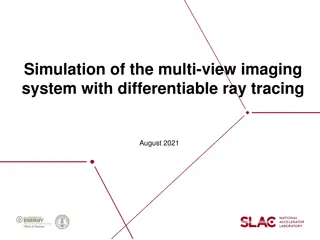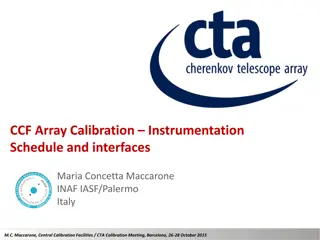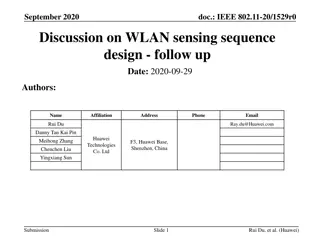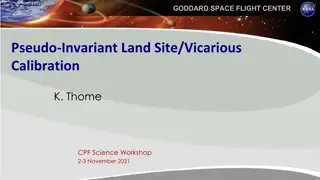Sparse Millimeter-Wave Imaging Using Compressed Sensing and Point Spread Function Calibration
A novel indoor millimeter-wave imaging system based on sparsity estimated compressed sensing and calibrated point spread function is introduced. The system utilizes a unique calibration procedure to process the point spread function acquired from measuring a suspended point scatterer. By estimating the sparsity of the radar echo spectrum and denoising the PSF, the system achieves promising results with minimal samples. The technology aims to enhance applications such as security surveillance, gesture recognition, and medical imaging. Compressed sensing plays a crucial role in inferring sparsely represented signals from reduced sampling, showing potential in radar imaging for both indoor and outdoor scenarios.
Download Presentation

Please find below an Image/Link to download the presentation.
The content on the website is provided AS IS for your information and personal use only. It may not be sold, licensed, or shared on other websites without obtaining consent from the author.If you encounter any issues during the download, it is possible that the publisher has removed the file from their server.
You are allowed to download the files provided on this website for personal or commercial use, subject to the condition that they are used lawfully. All files are the property of their respective owners.
The content on the website is provided AS IS for your information and personal use only. It may not be sold, licensed, or shared on other websites without obtaining consent from the author.
E N D
Presentation Transcript
Indoor Millimeter-Wave Imaging Based on Sparsity Estimated Compressed Sensing and Calibrated Point Spread Function R12942023
Outline Introduction Imaging Formulation Based On FMCW Signals Compressive Sensing PSF Calibration Measurement Setup & Result Reference
Outline Introduction Imaging Formulation Based On FMCW Signals Compressive Sensing PSF Calibration Measurement Setup & Result Reference
Introduction A sparsely-sampled indoor millimeter-wave imaging system using sparsity estimated compressed sensing accompanied by a novel calibration procedure to process the point spread function (PSF) acquired from measuring a suspended point scatterer is presented in this work. The sparsity of the to-berecovered radar echo spectrum is estimated with the dispersion relation of the waves, and the truncated singular value decomposition is utilized to denoise the PSF measured from the simple measurement scheme. Our low-cost imager yields promising results when the randomly kept samples are as few as 30% of the complete uniform measurements with a better- represented PSF for image reconstruction.
Introduction MILLIMETER-WAVE (MMW) imaging in indoor scenarios has numerous applications, such as security surveillance, human gesture recognition, and medical imaging. Conventional planar MMW imaging often requires mechanical raster-scanning of a transceiver probe or a dense 2-D uniform array of transmitting (Tx) and receiving (Rx) elements, leading to long measurement times or complex circuit routing. To expand the applicability of MMW imaging for practical uses, imaging from reduced samples has become an important topic for research.
Introduction Compressed sensing (CS) is an emerging field of exploration to infer sparsely represented signals from reduced sampling. CS has been shown to be a feasible technique for radar imaging from reduced samples via simulations, and experimental systems for both outdoor, and indoor scenarios. However, the sparsity of the measured radar echo to ensure a high probability of successful image reconstruction has not been thoroughly studied yet. Therefore, the signal attributes of the radar echo must be investigated to gain a better understanding of sparse array element placement.
Introduction In practical imaging systems, the point spread function (PSF) characterizes the impulse response of the imaging environment and the physical effects of the sensor. The PSF can be obtained by measuring a point scatterer of unit volume and utilizing it as an integration kernel. PSF measurement in the terahertz regime has been conducted by an acoustic levitation system. Additionally, superimposed PSF measurements have been conducted for active incoherent MMW imaging to capture sparse targets. However, these techniques demand complex measurement setups.
Introduction We begin by observing the finiteness of spectral components for propagating plane waves. Notably, non-sparse target objects exhibit sparse representations when we focus solely on the relevant region within the 2-D spectrum of the radar echo. As for calibrating the measured PSF, we devise a simple and relatively lowcost point scatterer placement setup and a denoising procedure that profoundly improves the signal-to-noise ratio (SNR) of the PSF. By combining both methods, we propose a framework for sparse indoor MMW imaging that can be further extended to fixed array imaging systems.
Outline Introduction Imaging Formulation Based On FMCW Signals Compressive Sensing PSF Calibration Measurement Setup & Result Reference
Imaging Formulation Based On FMCW Signals ??: signal amplitude (accounting for the attenuation caused by reflection, path loss, and mixer conversion from the ith point target) beat frequency frequency slope round-trip delay
Imaging Formulation Based On FMCW Signals To prevent aliasing artifacts :
Outline Introduction Imaging Formulation Based On FMCW Signals Compressive Sensing PSF Calibration Measurement Setup & Result Reference
Compressive Sensing By applying CS techniques, the fully-sampled radar echo can be estimated by solving the basis pursuit denoising (BPDN) problem. T sparse representation of the radar echo ?? sub-sampled measurements tolerable noise level sparsifying matrix, which is chosen as the 2- D discrete Fourier transform (DFT) y original vectorized radar echo measurement matrix that defines the physical position of samples, randomly selecting m rows from the identity matrix ( )
Compressive Sensing measurement matrix that defines the physical position of samples, randomly selecting m rows from the identity matrix ( ) p sparsity of the radar echo determined by the support of T, which is estimated using the relevant region of S(??, ??) to locate the crucial components
Compressive Sensing 1. CS recovery of radar echo: Measure the scene with random sub-samples and retrieve the complete 2-D radar echo by solving (6). ???? wavenumber of ???? ?? = ?? sampling interval ?? = ?? 2. Image reconstruction: Reconstruct the target reflectivity function by solving (3).
Outline Introduction Imaging Formulation Based On FMCW Signals Compressive Sensing PSF Calibration Measurement Setup & Result Reference
PSF Calibration 4 mm 4 mm 1 mm
PSF Calibration truncated singular value decomposition (TSVD) singular value decomposition (SVD)
Outline Introduction Imaging Formulation Based On FMCW Signals Compressive Sensing PSF Calibration Measurement Setup & Result Reference
Measurement Setup & Result IWR1443 DCA1000EVM LFM signals ( 77GHz ~ 81GHz ) with in-phase and quadrature (IQ) demodulation a single Tx/Rx channel pair z = 30 cm Aperture size = 18 cm x 18 cm Sampling interval = 3 mm
Measurement Setup & Result balsa board ? 1.22 strongly scattering case (copper) w/o CS with CS
Measurement Setup & Result balsa board ? 1.22 weakly scattering case (RT/duroid 5880) w/o CS with CS
Outline Introduction Imaging Formulation Based On FMCW Signals Compressive Sensing PSF Calibration Measurement Setup & Result Reference
Reference H. -J. Yang, T. -Y. Lin and S. -Y. Chen, "Indoor Millimeter-Wave Imaging Based on Sparsity Estimated Compressed Sensing and Calibrated Point Spread Function," in IEEE Antennas and Wireless Propagation Letters, vol. 23, no. 6, pp. 1680-1684, June 2024
